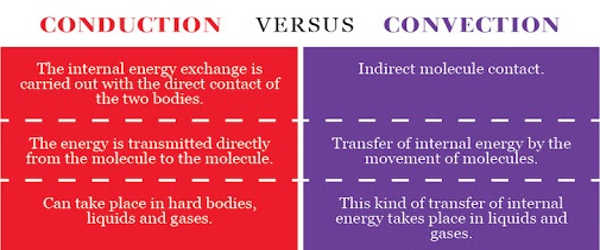Convection is the movement of heat by the actual motion of matter, whereas conduction is the transfer of heat energy by direct contact. Conduction occurs most commonly in solids due to molecular collision. Convection in fluids occurs due to the mass movement of molecules in the same direction. In conduction, heat is transferred through a heated solid substance, whereas in convection, heat energy is transmitted through an intermediate medium.
Difference between Conduction and Convection

CONDUCTION
- Conduction is a process in which transfer of heat takes place between objects by direct contact.
- It is a process in which heat is transported between parts of a continuum, through direct physical contact.
- It shows, how heat is transferred between objects in direct contact.
- Conduction is defined as the process that allows for the direct transfer of heat through matter due to temperature differences between adjacent parts of an object. It occurs when the temperature of the molecules in a substance rises, causing vigorous vibration. The molecules collide with surrounding molecules, causing them to vibrate as well, resulting in thermal energy being transported to a nearby part of the object.
- Simply put, whenever two objects come into direct contact with one another, heat is transferred from the hotter object to the colder one due to conduction. Furthermore, conductors are objects that allow heat to easily pass through them.
- Conduction occurs as a result of temperature differences, i.e. heat flows from a high-temperature area to a low-temperature area.
CONVECTION
- Convection refers to the form of heat transfer in which energy transition occurs within the fluid.
- It is the principle, wherein heat is transmitted by currents in a fluid, i.e. liquid or gas.
- It reflects how heat travels through liquids and gases.
- In science, convection refers to a type of heat transfer that occurs only in fluids and is caused by real movement of matter. Fluid refers to any substance whose molecules can freely move from one location to another, such as liquids and gases. It occurs naturally or even forcibly.
- Gravity plays a significant role in natural convection, causing the hotter part of the substance to expand when heated from below. Due to buoyancy, the hotter substance rises because it is less dense, and the colder substance replaces it by sinking to the bottom due to high density, and the process continues. When a substance is heated, its molecules disperse and move apart, resulting in convection.
- Convection occurs as a result of density variations, causing heat to move from a low-density region to a high-density region.
















